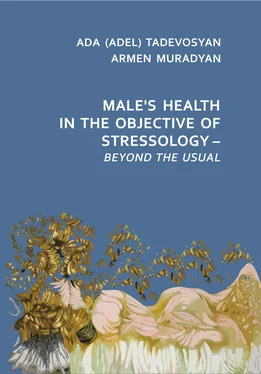To imagine the range of dissociative manifestations, contemporary researchers both theorists and experimenters use the concept of dissociative continuum. According to this concept, the whole spectrum of dissociative phenomena is located along a certain continuum, at one end of which are placed normal symptoms of dissociation, often encountered in everyday life, while at the other end of this continuum are “heavy” forms of dissociative psychopathology, observed in patients with dissociative disorders, post-traumatic stress disorders (PTSD), schizophrenia.
Normal dissociative processes in daily life are manifested as absent-mindedness, scattering or absorption in any occupation. More abnormal states, but not yet symptoms, are trance states, for example, with deep hypnosis.
The problem of dissociation with its manifestation variations becomes a leader in understanding the changes in the psyche, determining the key tendency in shaping the mentality, world-view and behavior in a person’s life. It is one of the leading mechanisms in the development of a variety of clinical manifestations. Studying the dynamics of dissociative relationships, in fact, is the core of psychoanalytic counseling.
Interdisciplinary approach. The desire to examine a modern male’s life in an attempt to understand the cause-effect relationship between the factors determining the current state of males’ health and their relatively early mortality compared with females’, logically led to the choice of an interdisciplinary approach that allowed us to consider the studied issue from the positions of psychology, physiology, neurophysiology, neuroendocrinology.
Humanistic psychology or the “third force” in psychology as a scientific trend emerged in the fifties of the twentieth century opposing itself to the two already existing trends – behaviorism (behavior psychology) and psychoanalysis. It treats a person as an open self-developing system that has phylo- and ontogenetic history. In each of us there lives a great story – the history of the life of mankind, about which C. Jung figuratively has written that behind each of us, as behind a running wave, the pressure of the ocean of world history is felt. Small history is an individual real life story of a specific individual. In key moments of each history there occur quantum leaps determining subsequent development of a person. Thus, in the great history these are development and improvement of the higher nervous activity (HNA), appearance and development of the second signal system, consciousness, mental adaptation; in the small history these are age crises, overcoming mental traumas. These crucial points (critical periods) are like “waking-up experience”, refreshing perception and behavior after which a person “acquires new space, new skin, new start and new life; even at the age over 75” (I. Yalom, publ. Eksmo, Moscow, 2014, p. 511).
Now scientists are engaged in “a riddle of neuroevolution” with its basic question: “How in the ways of biological evolution have emerged mind and human brain?” The problem of neuroevolution connects biology to psychology. And today, scientists realized that the main efforts of the evolution of the animal world have been spent just to create the human brain. They found the genes responsible for the key functions of the brain – learning and memory formation. It is in the course of natural selection, which affects functions and structures increasing survival or reproduction, that population changes in the gene frequencies associated with these functional systems occur.To understand the psyche as a function of certain dynamic organization of the brain structures, it is necessary to understand how these structures and their organization emerged in the course of biological evolution. It is part of the problem of morphological evolution. By the molecular cloning techniques it became possible to calculate that out of approximately 80–100 thousand genes composing the genome of the rat about 50–60 thousand are expressed in the brain, the expression of more than half of them being brain-specific. In the usual state of the brain these genes are “silent” but as soon as there is something that requires memorizing, they are activated and then, having done their work become “silent” again. But unlike other somatic organs, many of these genes are activated in the brain again in the situations of novelty and learning.
The two phases of the evolutionary cycle – maturation and adaptive modifications of functional systems providing survival, are closely related at the level of gene expression regulation mechanisms. In fact, the processes of morphogenesis (biology) and development never cease in the brain, but only pass under the control of cognitive and volitional processes (psychology). This similarity makes you think about the intense evolutionary interactions and transitions between these two domains. There is the reason to believe that it is the study of these interactions that can answer one of the most complex and challenging issues of modern science – how in the course of phylogenesis the brain became the organ that determines not only behavior, activity, health, illness, but also the evolution of genome.
Just a few decades ago, scientists believed that the brain is unchanged and “programmed” and that most forms of its damage are incurable. The book by Norman Doidge “ Brain Plasticity. Startling facts about how thoughts can change the structure and function of the brain ” (translation, publ. Eksmo, Moscow; monograph, 2011, p. 539) – is a remarkable and hopeful description of infinite capacity of the human brain to adapt. Dr. Doidge, a prominent psychiatrist and researcher, was struck by the transformations occurred with his patients.
Discovery of the fact that thoughts are able – even in elderly age – to change the brain structure and functions, is the greatest achievement in neurology for the past four centuries.
Norman Doidge suggests a revolutionary view on the human brain. He talks about brilliant scientists, promoting yet a new science of neuroplasticity, and about astonishing successes of people whose lives they have changed. He gives examples of stroke patients recovering their facilities; the case of a woman born with a half of the brain, which reprogrammed itself to perform the functions of the missing half; stories of overcoming learning disabilities and emotional disorders, increasing the level of intelligence and restoration of the aging brain. His first reports contradicted the generally accepted view about the brain and its functioning, so he began studying the new science – neuroplasticity. He wrote: “The idea that the brain is capable of changing its own structure and functioning thanks to the person’s thoughts and actions – is the most important innovation in our ideas about the human brain since its anatomy and work of its substantive structural unit – neuron was first outlined in general terms. This is a revolution!
Revolution associated with the brain neuroplasticity, among other things, cannot but exert influence on our understanding of how love, sex, grief, relationships with people, education, addictions, culture, technology and psychotherapy are changing our brain…”. But neuroplasticity is capable of forming both flexible and rigid behavior – the phenomenon of “plastic paradox”. Plastic change once occurred in the brain structures as a result of its fixation may interfere with other changes. Only the understanding of both positive and negative impact of plasticity on our brain allows us to fully realize the limits of human capabilities.
His discovery was based on the work of, first of all, Alexander Luria (1902–1977) – famous Russian psychologist, one of the few major theoretical psychologist and experts, well-known in the West. Luria proved the plastic possibilities of “higher mental functions” as far back as in the 40-ies of XX century. During World War II, he worked with a group of colleagues in rehabilitation of wounded with severe brain injuries (contusions and brain injuries). Then the psychologists achieved striking results: completely hopeless and paralyzed people began to move normally, walk and talk. He obtained practical results that were quite expected! They corresponded to the known in the Soviet Union since the 30-ies theoretical developments proving plasticity of brain and psychological functions (the work of physiologists N. A. Bernstein, P. K. Anokhin, brilliant psychologist L. S. Vygotsky, fundamental works on the psychology of S. L. Rubinstein, A. N. Leontiev and others) and only confirmed the psychological concepts in practice. A. R. Luria became the founder of quite a new direction in the world psychology – neuropsychology [2] Neuropsychology – the branch of psychology at the intersection of psychophysiology and neurology, studies the brain mechanisms of higher psychological processes (speech, thinking, perception, attention, memory) on the material of brain lesions and possibility of their recovery. – Editor’s note.
.
Читать дальше












